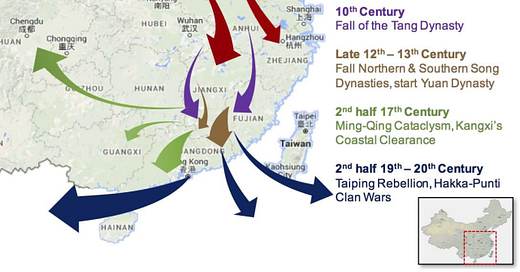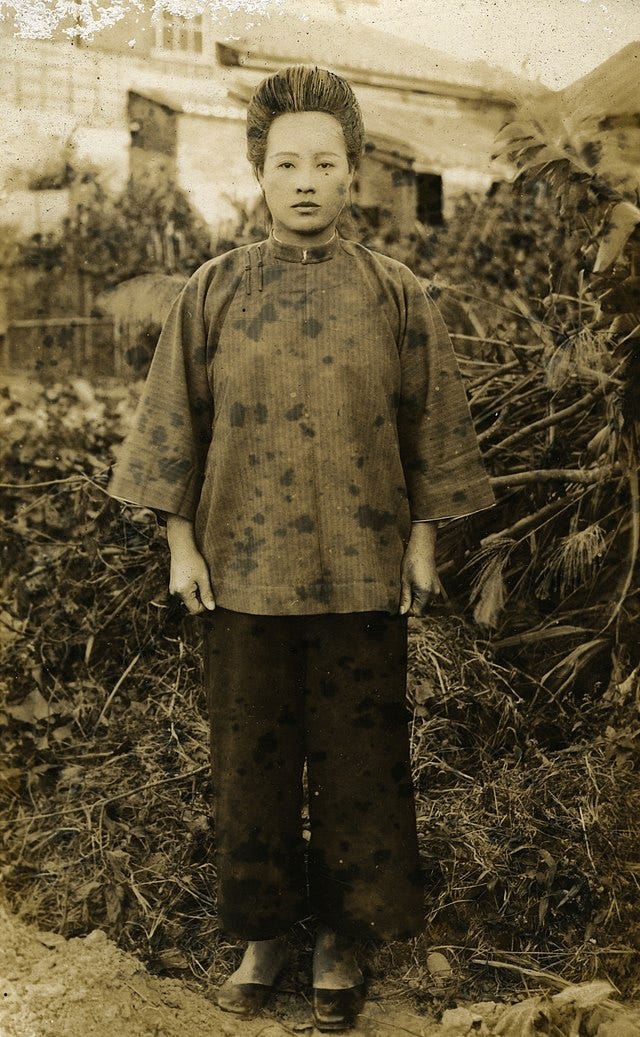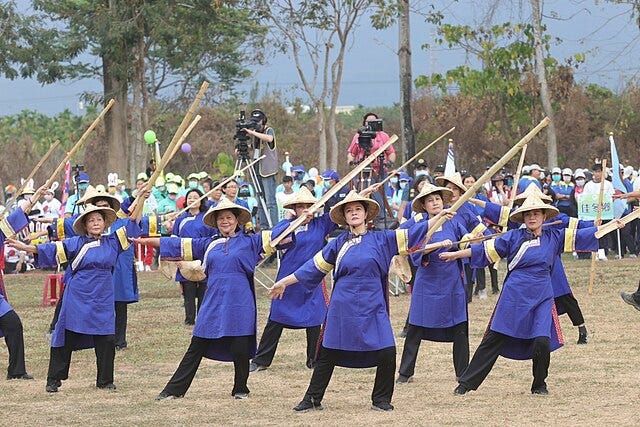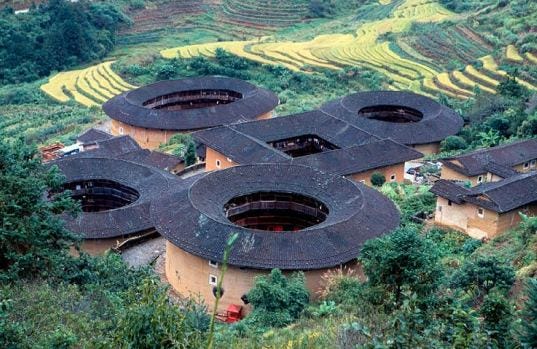Hakka Cultural Characteristics, Part 6 of Chinese conflicts of the California Gold Rush
The Saga Continues.
Greetings,
First, some good news and bad news, you guys decide which is which. While on one hand, I am working on a piece with my thoughts on the recent election and Donald Trump’s return to power, on the other hand, it won’t be this week. But it’s coming, and I think it will offer a perspective that you won’t hear elsewhere. Really, Donald Trump is a man of many talents, and one of those is an amazing talent for dominating the media and making others focus attention on him. He’s a narcissistic attention-hog who cannot be ignored, and, alas, while I resent it, it seems I cannot ignore him either, so I sit here writing about him, while wondering why so few people are writing or thinking about me and my substack and sharing my column. It’s just not fair. If only I had a sociopathic mentor like Roy Cohn in my early years or a grandfather who had made money doing things like running a brothel in the Yukon. If I had, people would read this and share it more. Nevertheless, that’s coming. And while I am at it, I am also working on a piece on the so-called “Ancient Chinese curse.” “May you live in interesting times.”
Relevant as it is right now, is the so-called Chinese curse, “May you live in interesting times,” a real thing, real history, or some sort of pseudo-history? Stay tuned and find out, and in the meantime keep your wits about you and stay clear headed because we very much are living in “interesting times.” And be nice to each other and learn to live in harmony with your neighbors who voted opposite the way you did. Very few of those people are evil. Remember that. Um, assuming you are American. Many of you are not, and if you live overseas or in Canada, a lot of folks here envy you so count your blessings and be nice to each other, too.
BUT IN THE MEANTIME, IF YOU ARE ABSOLUTELY DYING TO GET MY THOUGHTS ON DONALD J TRUMP, WELL, I DID WRITE A BOOK ABOUT HIM. IT’S THIN, IT’S LOW-PRICED, AND IT HAS GOTTEN VERY GOOD REVIEWS. AND IT WILL MAKE YOU MORE AWARE OF THE TRICKS AND TECHNIQUES DONALD TRUMP HAS USED TO ACCOMPLISH THINGS NO ONE ELSE ANYWHERE HAS EVER ACCOMPLISHED. REMEMBER DO NOT EVER, EVER UNDERESTIMATE DONALD J TRUMP AND READ THIS BOOK:
Scams from the Great Beyond --The Presidential Edition: A Skeptical Look at Our 45th President Using the Tools of a Paranormal Debunker and Historian
PLEASE CHECK IT OUT. and now for the weekly column on “Mostly Asian History.”
But what about the Hakka people and the California Gold Rush?
Oh yeah. Let's return to that. Thanks for coming back. To rehash . . .
A few weeks ago, we began by looking at a situation in a place called Chinese Camp California in 1856. It was documented that at that time, in that place, two large groups of Chinese gold miners had faced each other in public and then fought a battle. This is unusual. Even stranger, none of the local White Californians who observed the events seemed to understand why this happened, while the Chinese involved made little attempt to explain. Not only that, a similiar event had occurred in Weaverville, California, on 1854 with the same lack of local understanding.
Digging deeper, I discovered that the organizations were not “tongs,” sworn brotherhoods voluntarilly created for mutual self protection and self interest, but instead Chinese “Companies” or “Huiguan” ( 會館 ). These were involuntrilly joined organizations whose membership was based on place of origin in China, more specifically, as almost all of the Chinese in America at the time came from the Pearl River Delta in southern China, more specifically at this time these organiztions and their membership were defined by the place of origin in the greater Pearl River Delta region.
And not only that, in each of the two battles, the organizations that fought had been the same, and they had come from not just two different places, but two different ethnic and language groups called the Cantonese and the Hakka.
Therefore, it seems to really understand these events we need to take a transnational approach to understanding them. What the Chinese people in California were doing can best be understood in part by also looking at what was happening in China at that time. More specifically, understanding events in the region of China where they came from could help understand these events. China is a big place, after all.
And this means understanding who the Hakka people were and their relationship with their primarilly Cantonese neighbors.
The Hakka were a sub-group of Chinese who centuries ago had been driven from their northern homeland and drifted south, seeking places to live and settle. When they came to southern China and the province of Guangdong (Canton), friction developed as they competed for resources with the Cantonese people who were already living there. Violence was part of this.
This in turn, caused further Hakka migration meaning that the Hakka people today make up a large percentage of the overseas Chinese in south east Asia, as well as elsewhere overseas, as well as a large percentage of the population of Taiwan, Taiwan in the 19th Century being a frontier region of China where newcomers were settling and building homes.
Hakka migrations in Chinese history
Source: Wikimedia Commons
Like with everything else, there’s a lot of good stuff on Wikipedia. And, yes when I started this last March, I did plan to avoid citing Wikipedia at all costs, but those plans changed. Wikipedia is useful, very useful, if used with care and part of that care means tracking things back to the original sources and using non-wikipedia sources to be able to put its claims and statements in context and check for bias.
So, one can do some reading here: https://en.wikipedia.org/wiki/Hakka_people or https://en.wikipedia.org/wiki/Hakka_culture if you would like.
If you would like the government of Taiwan has a Hakka Affairs Council and you may visit their website: https://english.hakka.gov.tw/
In the meantime, more on the Hakka people.
HAKKA CLOTHING STYLES
The Hakka traditionally dressed a bit differently than other Chinese. These days, they tend to dress like everyone else except at heritage and ethnic festivals and similiar events.
This is an old drawing of some Hakka people dating from the Philipines in 1590 AD. It comes from something called The Boxer Codex. It comes from Wikimedia.
Another photo from Wikimedia. This shows a Hakka woman in China, probably from sometime between 1935 and 1945.
Here are some Hakka women in trditional clothes performing a dance at a festival in Taiwan today.
For more on Hakka clothing styles visit: https://theculturetrip.com/asia/china/articles/an-introduction-to-hakka-traditional-dress or https://english.hakka.gov.tw/Content/Content?NodeID=684&PageID=43365&LanguageType=ENG
HAKKA CULTURAL CHARACTERISTICS
LANGUAGE
In linguistic circles, the exact definitions and differences between what is an accent, dialect, and language is fuzzy, with the choice of terminology or label often decided more by politics than by another standard. And modern Chinese politics emphasizes that the Han are a single group with a single shared identity.
Therefore, the different ways of speaking among the different styles of speech used by all the people and peoples lumped together as members of the Han ethnic group are all officially labelled as dialects. After all, a single group would speak a single language.
Therefore, these are considered dialects of Chinese even though many are more different from each other than the languages of Europe are from one another. Italian, Spanish, and Portuguese are all much closer to each other than Cantonese or Taiwanese is from Mandarin.
Now this is kind of a cute video where two young women, one primarily Cantonese speaking and the other Hakka speaking, chat back and forth trying to see if they can understand each other and sometimes giggling when they can’t. It’s a fun and simple way to get a sense of what Chinese dialect differences are like.
The video below shows the differences between the Hakka, Cantonese, and Mandarin dialects. Notice that they all use (mostly) the same characters to write (mostly) the same words. Dialects are distinguished by not just different pronunciations of words, but sometimes by different ways of saying the same thing including using different expressions and word choices.
(i.e in English with our dialects, one dialect might say “Hello sir, how are you?” Another English language dialect might say “Yo my man, what’s up?” and a third could say “Good day mate, how’s it hanging?” )
THE ROLE OF WOMEN
The Hakka had a more egalitarian and respectful attitude towards their women than many of the other Chinese sub-groups. They encouraged them to be productive and attain some education. Unlike many other Chinese groups of the time, the Hakka did not bind the feet of women and girls. (This painful practice crippled women making it difficult for them to walk for the sake of what was considered a standard of beauty among much of the Chinese upper class.) Part of the motivation behind this was simply economic necessity and need, and desire to maintain the ability for women to be productive, contributing members of society who were able to help their family and neighbors.
It should be mentioned, for the record, that despite this there were very few Hakka women in California at this time, just as there were few Chinese women of any kind in California for several reasons.
CUISINE
Hakka have and had their own distinct cuisines. Rather than get into this in depth, I have shared a few videos from YouTube.
The first comes from The Fung Brothers. The Fung Brothers are a pair of young, Chinese American YouTubers in the Southern California greater Los Angeles area who have a very popular series of videos. Many of these focus on food, but others focus on different aspects of Chinese American culture. While at times, a bit cloyingly hip (they often wear backwards baseball hats, move their hands a lot, and say “yo” a lot), the Fung Brothers are fun, and they do share good information. This one is no exception.
Chinese Cooking Demystified is one of my favorite YouTube channels and I proudly support them with a voluntary donation of two dollars a month. (Big spender that I am, and, in return, I get their videos a day early.
This gives a good introduction to Hakka history and some simple Hakka food. They also have a separate video where they teach how to make Hakka stuffed tofu.
Being a fan of the Chinese Cooking Demystified YouTube channel, I decided it could not hurt to share this one, too, even though it lacks the introduction to Hakka culure material above
And here’s a third one, I found. It comes from a YouTube channel funded by the Chinese government but it does contain good information on Hakka cuisine and culture in both Southeastern China as well as in Toronto.
Hakka Architecture
The Hakka have some unique architectural styles, particularly in SE China.
The Hakka people, a sub-group of Chinese (Han Chinese), often lived in large communal houses with thick outer walls. This is a photo of some traditional Hakka houses in Fujian province in Southeastern China. A house such as this would often be home to 80 families. This photo came from an article on these houses. For the full article, https://inhabitat.com/chinese-hakka-houses-form-self-sustaining-communities/hakka-houses-5/
And, yes, I did share this same link last week.
GENERAL VIDEOS ON HAKKA CULTURE AND HISTORY
One thing I don’t understand about you, my wonderful readers, is that very few of you click on and watch these wonderful videos that I share each week. Therefore I am resharing these very good videos again as so many of you missed them last time.
So here are several good videos on Hakka culure and history and am sharing my favorites below.
Below I am sharing a very interesting series of videos called “Yanyan Go Around in China.” On this YouTube Channel, a woman named YanYan, surprise, goes around China and describes what she finds on her trips. The channel contains over six hours of YanYan visiting Hakka cultural sites. I confess, I have not viewed them all. But if you were to do so, I am confident that you would learn a great deal.








